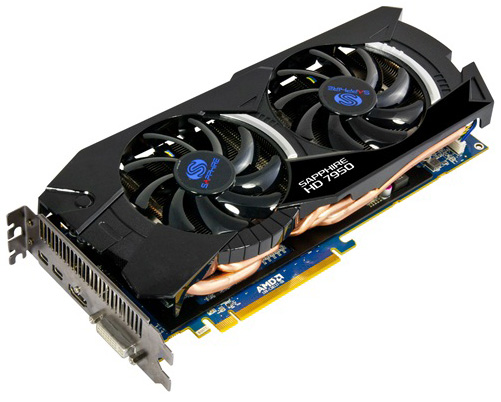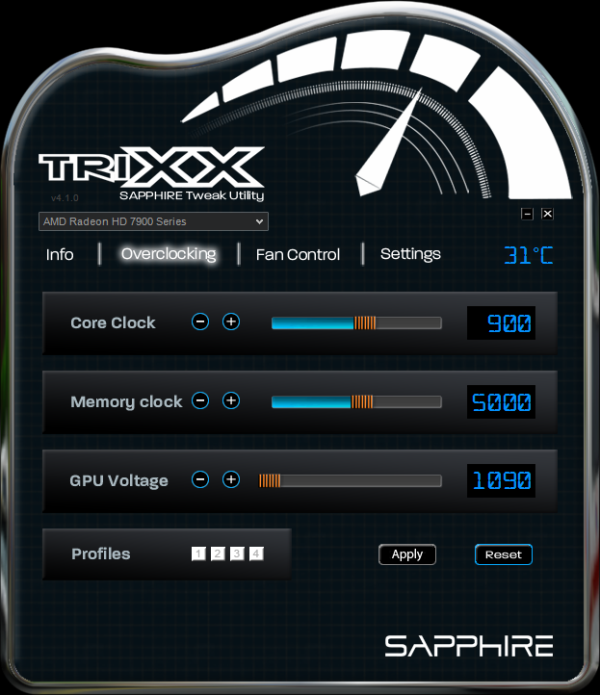AMD Radeon HD 7950 Review Feat. Sapphire & XFX: Sewing Up The High-End Market
by Ryan Smith on January 31, 2012 9:02 AM ESTMeet the Sapphire HD 7950 Overclock Edition
Since our reference 7950s are built on the 7970 PCB and cooler, we’re going to jump right into our vendor cards starting with the Sapphire HD 7950 Overclock Edition.
As with all of the 7950 cards launching today, Sapphire’s HD 7950 Overclock Edition uses the AMD 7950 PCB. This is a slightly shorter PCB measuring 10.25” long, saving .25” over the 7970 PCB by eliminating a few components that the lower board power of the 7950 makes unnecessary. The PCB is otherwise very similar to the 7970 PCB, utilizing 12 GDDR5 memory chips organized around the Tahiti GPU, while at the top you’ll find the 2 CrossFire connectors, a pair of 6pin PCIe power sockets, and the BIOS selection switch. The latter will be of particular interest to unlockers, as the switch should make it possible to safely attempt to unlock the 7950 into a 7970.

Moving on, as this is a semi-custom card the real differentiation is in the factory overclock and the cooler. On the performance side of things Sapphire will be shipping the 7950 Overclock Edition at 900MHz core and 5GHz memory, representing a 100MHz (12.5%) core overclock and no change on the memory clock.
Meanwhile for the cooler Sapphire is using what they’re calling the Dual-X cooler. The Dual-X is yet another double-wide dual-fan open air cooler, with 2 fans providing copious airflow over an aluminum heatsink running virtually the entire length of the card. Sapphire’s fan cutouts are just a bit bigger than most other dual-fan coolers and placed a bit higher, and as a result the Dual-X cooler is a bit taller than the PCB by about 15mm at its highest point. Meanwhile the cooler is also a fair bit longer than the PCB, putting the total card length at 11”.
Moving below the fans and the heatsink we’ll find the heatpipe assembly, which is responsible for carrying heat from the GPU to the heatsink. The Dual-X uses 5 copper heatpipes of varying radius that run from one end of the heatsink to the other. The 5 heatpipes converge at the base of the assembly, where a copper baseplate provides contact with the GPU. Meanwhile cooling for the VRM MOSFETs and RAM is provided by a black aluminum plate, which is placed over those components with heat transfer provided by the use of thermal pads. There is no connection between the plate and the heatsink, so the only heat dissipation from the plate is provided by whatever airflow from the fans reaches the plate.

At the front of the card we’ll find the display ports, which as this is an AMD PCB the card utilizes the standard AMD 7000 series port configuration of 1 DL-DVI port, 1 HDMI port, and 2 mini-DisplayPorts. Filling out the second slot is the grating for ventilation, though even with the ventilation slot the usual precautions for an open-air cooler apply: you’ll need a case with enough airflow to handle the roughly 200W of heat the card is capable of dumping inside of your case.
Rounding out the package is the usual collection of dongles and materials. Sapphire includes 2 molex-to-6pin PCIe adaptors, an HDMI to DVI dongle, a miniDP to DisplayPort dongle, a DVI to VGA dongle, and a 1.8m HDMI cable. Along with the dongles Sapphire packs a quick start guide and a driver installation CD.
The only thing you won’t find packed in the box is TriXX, Sapphire’s in-house overclocking utility. TriXX has been around since the 6900 series, but as this is the first high-end Sapphire card we’ve reviewed since it was released, this is the first time we’ve had it available for a review.
Fundamentally TriXX is a fairly well designed, albeit barebones overclocking utility. Along with an info readout similar to GPU-Z, TriXX provides overclocking and fan control support for Sapphire’s cards, including support for custom fan profiles and more importantly voltage control. With TriXX it’s possible to overvolt most of Sapphire’s performance and high-end cards, and as Sapphire uses AMD reference PCBs it also works with any other cards using AMD’s PCBs.
Beyond these features there’s little more to TriXX. It’s not an all-encompassing video card utility like MSI’s Afterburner, which means it comes up short if you need more functionality but it's exactly what you need if you just want to overclock. To that end it’s a clear step up compared to most other manufacturer’s poorly designed utilities, and from a design perspective its only real sin is the hard to read blue-on-black text. Otherwise it’s a competent overclocking utility that does exactly what it’s supposed to and provides voltage control for those who need it.
Finally, Sapphire will be selling the 7950 OE for $479, $30 over the baseline 7950 MSRP. Meanwhile the warranty on their card is their standard 2 year warranty.















259 Comments
View All Comments
chizow - Tuesday, January 31, 2012 - link
Now it starts to become obvious why people shouldn't be doing cartwheels in the streets over Southern Islands. Its a nice chip, it really is. But the problem with its pricing just became even more obvious with the 7950 as AMD is selling you yesterday's performance at next-gen prices. In other words, if you wanted this level of performance, you could've gotten it a year ago with the GTX 580 for almost the same price....over a year ago....And that's why AMD's pricing of these parts fails. With the 7950 it all comes into focus and if it wasn't clear before, it will become crystal once Kepler drives the nail home when it launches at its expected prices and performance levels. What's left for AMD to launch? A 7870 that's as fast as the 6970 but costs $50 more? A 7850 that's as fast as the 6950 but costs $75 more? Do we really think Nvidia is going to launch a 580 equivalent at 28nm and price it at $450? See how it all comes into focus?
But Nvidia really has a chance to return the favor to AMD here with a pricing debacle of GTX 260/280-esque proportions. If GK104 comes within spitting distance of the 7970 or even 7950 at $300, AMD is going to look really bad. If GK110 beats the 7970 by 20-25% and costs only $500, AMD execs will be jumping out of windows. We're talking about issuing rebate checks that AMD can't afford to write on every 7950/7970 sold at these ridiculous prices for however many months it takes until Nvidia releases Kepler.
Goty - Tuesday, January 31, 2012 - link
1) I believe you mean "consistently faster than last-gen performance for the same price", which is how it will remain until NVIDIA gets a card out that can compete.and
2) Keep dreaming.
chizow - Tuesday, January 31, 2012 - link
1) Well the good news is Nvidia decided to compete over a year ago when they launched the GTX 580. At these prices AMD has set, Nvidia is still amazingly competing with their 14 month old last-gen parts.and
2) The better news is AMD has set the bar extremely low for Nvidia. Should be easy pickings for Kepler.
halo37253 - Tuesday, January 31, 2012 - link
Yet a overclocked 7970 is about as fast as a gtx590, yeah... nvidia sure is competing. lolReally there is no reason to get a nvidia card right now, with the gtx580 and its continuing high costs not even able to hold its own again even a 7950. Once the 7xx series launches I can see AMD launching the hd89xx series no to long after with XDR2 memory and higher clocked cores.
For overall performance per watt it seems AMD cant be touched right now.
kashifme21 - Tuesday, January 31, 2012 - link
The real question is, Do we really need these upgrades anymore. I mean todays games barely push tech. Most of my friends are happy with their 5870's and GTX 480's we bought about 2 years backThing is games are designed with consoles in mind and with next gen console hardware rumors to be around the level of 6670 GPUs, why would anyone upgrade anymore, unless they intend to be running multiple screens.
I personally run GTX 580 SLI. I think i personally wont be upgrading until i see a game that actually stresses my system in eyefinity settings.
Its a sad state but many games recently released dont even support freatures like AA or even any pc options, games are rather straight console ports, with PC as an after thought. Why buy such expensive hardware for ports?
jleach1 - Tuesday, January 31, 2012 - link
I agree. Even my 5850 hasn't stressed much in recent games...and I bought it for 280 USD a couple years ago.Performance per dollars, and temp per dollar, AMD is on target, more often than not....now, if only we could get the FX sorted out...
I used to buy nvidia cards, but haven't since the 5000 series, and it looks to continue this way.
The moral is, competition is ultimately what brings prices down and motivation to up the performance.
I hope AMD can throw out something cool soon on the CPU side, because while I always have, and likely will continue to buy Intel, I love the competition. Sorry, I sorta gave up on AMD after the i7-930 came out. But that doesn't mean I'm not rooting for them...even if it is only for the sake of competition.
TerdFerguson - Tuesday, January 31, 2012 - link
On the other hand, upgrading the 5850 that you've had for several years is going to require you to jump to a /higher/ price tier. That's insanity. If that kind of pricing structure existed for ANY other consumer electronics product, people would be vocally antagonistic. AMD deserves some antagonism.JonnyDough - Wednesday, February 1, 2012 - link
I disagree. Supply and demand. They don't have the supply and there's a big enough demand to keep prices inflated. Nobody can be upset at all about the prices. If you don't like them, don't buy the product. It's that simple. Capitalism fails us often, but here's a case where it works just fine. :)TerdFerguson - Wednesday, February 1, 2012 - link
By your foolish reasoning, AMD would be in top form if it produced and sold just a couple of hand-crafted units each quarter. That they can't meet volume demand is a failing, not a benefit.artk2219 - Wednesday, February 1, 2012 - link
I've got to say that I agree with JohnnyDough, in the short term keeping prices high and making a killing off of each card sold is a good thing for AMD, not so great for us consumers but again, its not like anyone is forcing you to buy it. However you are correct in that in the long term that is a failing strategy for a company like AMD, its not like they're making luxury sports cars :). Either way it makes no difference to me and it puts them in a great position for a coming price war with Nvidia and Kepler which will inevitably be faster, I just hope Nvidia does something about their power profile.